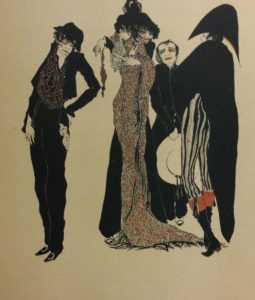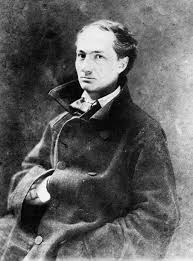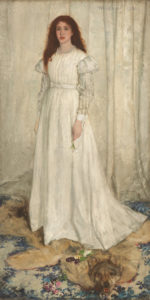The Decadent movement was an artistic and cultural movement of the late 19th century. Centred in Western Europe, it focused on the excess and artificiality of the world. The movement initially began and flourished in France and then spread to other parts and Europe and the United States.
Some of the key features of the art associated with the Decadent movement were self-disgust, scepticism and sickness towards the world, perverseness etc.

Table of Contents
French Decadent Movement
The first users of the word ‘decadent’ in France were writers, Theophile Gautier and Charles Baudelaire. It represented the culture that they termed as ‘banal progress’. Baudelaire referred to himself as a decadent in his collection of poems Les Fleurs du Mal, 1857 edition.
He stated that the decline of Roman tradition was a model for modern poets to articulate their passion. Later, he also said that the term ‘decadent’ included subversion of traditional styles and content, and finding delight in sensual experience.
Baudelaire’s friend, Fѐlicien Rops, who was a Belgian artist also contributed to the development of the French Decadent movement. He illustrated Baudelaire’s writing frequently and used gruesome, horrific style in his paintings which shocked the audience.
Rops was interested in the Satanic cults and frequently worked on the double threat of Satan and women. Other authors and writers conforming to the movement were Arthur Rimbaud, Stѐphane Mallarmѐ and Tristan Corbierѐ.
Decadents in England
In England, the Decadents entered with Arthur Symons, Oscar Wilde, Ernest Dowson and Lionel Johnson. They were members of the Rhymer’s Club and frequently contributed to The Yellow Book, which was a British quarterly periodical.
There were also poets like Algernon Charles Swinburn and illustrator such as Aubrey Beardsley. Although the primary source of inspiration for these writers and artist were Baudelaire, there was also huge reflection of works by more purely decadent members like Huysmans and Rachilde. They had a significant influence of Wilde as can be clearly found in The Picture of Dorian Gray.
The British decadents focused on the idea of creating art for art’s sake, seeking material excess and fulfilling all possible desires. However, they were also not flinching from using the tools of decadence for social and political purpose.
Beardsley was largely interested in the improvement of social order and aimed at inspiring transformation through the process of art-as-experience. Oscar Wilde was interested in socialism and published a work on whether socialism could be a liberating force.

Russia, Spain and The United States
Once again the Decadent movement was inspired by the works of Charles Baudelaire and Paul Verlaine. In Russia, the decadents focused on themes such as lack of morality, blasphemy, ignorance of physical health, sexual pleasure etc. they were especially fascinated with Death.
Dmitry Merezhkovsky was the first prominent Russian artist inspired by the Decadent Movement. Authors such as Konstantin Balmont, Fyodor Sologub, Valery Bryusov, Zinaida Gippius were also instrumental in promoting Russian Decadence.
In Spain, Francisco de Goya is believed to have introduced Decadence for the first time, which was almost a hundred years before France. Their works would reflect the exposure of injustice and oppression. Ramόn Casas and Josѐ María Lόpez Mezquita are considered the prominent artists of this period.
Their paintings depicted social conflicts and the police atrocities that were happening in Spain at that time. Books like El monstruo (The Monster) written by Antonio de Voyos y Vinient and Los Pazoz de Ulloa by Emilia Pardo Bazan are also products of this movement.
In the United States, there were few significant authors and artists associated with the Decadent movement. They usually saw it as a movement of France of the of fin de sieclé period. However, there was George Sylvester Viereck, an exception and wrote Nineveh and Other Poems (1907) that catered to the decadent movement.
Aestheticism and Decadence

Both Aestheticism and Decadence shocked the Victorian era and shook the foundation of Victorian values through their art. They foreground sensuality and endorsed artistic, sexual and political experiments. The two movements were, however, not the same as many tend to believe.
Aestheticism stresses more on art and the pleasure derived from it over the subject matter. In this discipline, poetry depended on complex verse, features verbal music and technical experimentation. An Aesthetic verse also requires a colourful and elaborate description.
Aestheticism also articulates an indifference towards the regular mundane life. For an aesthete, regular social life has a lower potential yield than art. He, therefore, retreats to art and an incessant pursuit of beauty. This aesthetic alienation and retreat from life are recapitulated in the verses.
In England, the aesthete tendency had found voice even before it was labelled so. Poems by Tennyson, Austin Dobson, Andrew Lang were all aesthetic in nature. Their poems focused on the detached realm of the Earth which had little to do with morality but operated entirely on the evocation of beauty and pleasure.
The Decadents, in contrast, rages against everything traditional. They define themselves through conflict and contrast. They express their contempt and disgust for prevalent values and norms, considering them degenerative.
This aggressive and aversive stance towards society results in the artist’s alienation, unlike the Aesthete who chooses alienation voluntarily, for something more beautiful. For example, if society considers sexual relations to be absolutely private, so much so that it becomes taboo (which was very much the case in Victorian society), the Decadent shall devote an entire work to the erotic descriptions of a night with a prostitute.
Hence, although both Aesthetes and Decadents had nothing to do with morality or immorality, they did not share the same stance towards society. The Aesthetes did not necessarily hate the society or attack it but the Decadents constantly did so. In this way, the ideology and outlook of both movements differed greatly from each other.
What Is Neo-Victorian Aesthetic Movement?: Exploration of modern interest and revival of Victorian aesthetics.